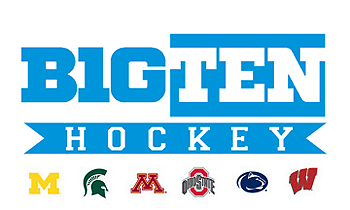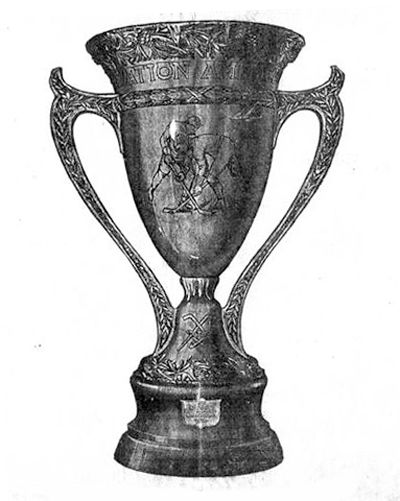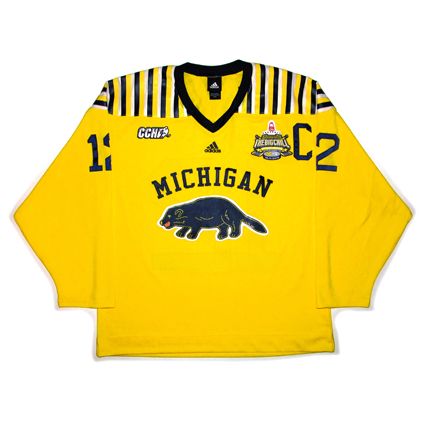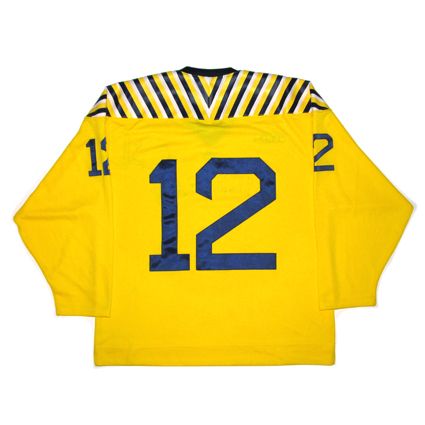When introduced as the Sabres new owner, he cried being in the presence of Gilbert Perreault, so you really do have to appreciate the man's passion for hockey and his undeniable love for his Sabres, and we do not mean "his Sabres" in the sense that he now owns them, but "his Sabres" in the way he has cheered for them as a fan since forever.
As a man of means beyond what most of us can comprehend, he has also generously donated $102 million to Penn State, the largest private gift in school history, to construct a brand new arena and pay for both the men's and women's club hockey teams to be elevated to Division I status - an incredibly selfless gift that will affect the lives of hundreds future arena employees and student athletes as well as those who will be employed in the construction of the new arena.
However…
There is also a man named Jim Delaney, who is president of the Big Ten conference, and another man named Mark Silverman, who is the president of the Big Ten Network, a channel which is in need of more programming and always looking to add to it's $242 million in revenue and $79.2 million in profit it generated in 2011, numbers expected to rise for the just completed 2012 in light of the 23% increase in ad revenue from 2010 to 2011. Silverman wants to be able to send more of those kinds profits to Delaney.
While there had been discussions regarding the creation of a Big Ten conference for hockey for years, they never amounted to anything, but now with the move to Division I by Penn State, there will be six hockey programs among the Big Ten's current 12 members, a very critical number, as six is the minimum number of teams required for the NCAA to issue an automatic bid into the NCAA tournament for a conference champion and the minimum number of schools needed under Big Ten rules to allow for a conference championship to be recognized.
With that magic number of six schools now reached thanks to the addition of Penn State, and an eager television network looking to add programming, the formation of the Big Ten Hockey Conference was announced in March of 2011, which will begin play in the 2013-14 season. The benefits for the six schools is the healthy increase in the amount prestige and publicity they can expect by being now affiliated with the "Big Ten" name, the exposure they will get from having a TV deal with the Big Ten Network and, of course, the money they will receive from the network while having to only divide it six ways by being members of a new, smaller conference.
Those six member schools are Michigan (with 9 national championships), Michigan State (3) and Ohio State, who are all leaving the Central Collegiate Hockey Association (CCHA), Minnesota (5) and Wisconsin (6), who are both leaving the Western Collegiate Hockey Association (WCHA), and the previously mentioned startup program at Penn State, who are going to enjoy the benefits of being able to step right into the highest profile hockey conference in the country.
While the news of five major schools leaving the their two established conferences was in itself a blow to those conferences, they easily could have continued as is, but that was not to be the case.
Oh, no. Not by a long shot.
The stronger schools of the WCHA and CCHA quickly began talks to combine into a new conference of their own, as reported and announced in July of 2011. The new conference was named the National Collegiate Hockey Conference and combines Colorado College (2), Denver (7), Minnesota-Duluth (1), Nebraska-Omaha, North Dakota (7) and later St. Cloud State of the WCHA with Miami of Ohio and then Western Michigan of the CCHA.
This news left the remaining schools in both the WCHA and CCHA reeling, and the other schools being left behind began to look at what they could do to protect their own interests, as the CCHA was now looking at five of it's 11 members leaving, while the WCHA was facing being gutted by the loss of eight of it's 12 members!
The next domino to fall was when Northern Michigan (1) announced it was leaving the CCHA in order to return to it's former conference, the WCHA. The CCHA effectively died when Alaska-Fairbanks, Ferris State and Lake Superior State (3) followed Northern Michigan to the WCHA in August with Bowling Green (1) doing the same on October 4th, followed the very next day by the CCHA's Notre Dame accepting an invitation to join Hockey East in 2013.
The move by Notre Dame in turn led to Connecticut leaving the Atlantic Hockey Association to join Hockey East in 2014 in order to get Hockey East back to an even number of schools. This move will require UConn to make some major changes to it's program, as they currently do not offer scholarships and their home arena seats less than 2,000 fans.
The ramification of all this movement is that the CCHA will cease to exist at the end of this year after 42 seasons of play, dating back to 1971-72.
Meanwhile, the WCHA will be gutted when it loses the likes of Colorado College, Denver, Minnesota, Minnesota-Duluth, Nebraska-Omaha, North Dakota, St. Cloud and Wisconsin (28 combined national titles in all), and will now be comprised of Alaska-Anchorage, Alaska-Fairbanks, Bemidji State, Bowling Green, Ferris State, Lake Superior State, Michigan Tech, Minnesota State-Mankato and Northern Michigan (8 combined national titles), taking the WCHA from the most dominant conference in the history of US college hockey, with 36 national titles to it's credit and a conference which sent all four teams to the Frozen Four in 2005, to a collection of cast-offs abandoned by the Big Ten schools and not invited to join the NCHC, which will be spread from the wilds of Alaska all the way to Ohio in the Eastern time zone, banded together for survival. The new WCHA will be virtually unrecognizable, as it will now have more teams in Michigan's upper peninsula than it will have in the states of Minnesota, Colorado, North Dakota, Nebraska and Wisconsin - combined!
In a situation no one wants, both Alaska schools will now be in the same conference, undesirable to the other conference members due to the high cost of travel expenses involved when making the trip to Alaska, as well as the large time difference, as Alaska is four time zones from the five WCHA schools located in Michigan and Ohio. How remote is Alaska considered to the other schools? A provision in the league playoffs dictates that both Alaska schools will automatically be paired together in the first round of the league playoffs regardless of their conference standing in order to avoid anyone having to travel to or from there!
About the only thing the "new" WCHA has going for it is that it will retain the MacNaughton Cup as it's championship trophy due to the retention of Michigan Tech in all the shuffling of schools.
The disappointments of this massive realignment are many, especially to those fans used to shorter road trips to away games due to conferences grouped geographically. For example, the western-most school in the new Big Ten, Minnesota, currently has eight conference rivals within 390 miles, will now find it's second closest opponent 650 miles to the east.
The other major disappointment is to the schools who worked hard to upgrade their programs from Division III to Division I, construct new buildings and sometimes wait years for acceptance into the WCHA, especially a school like Bemidji State, who spent 11 seasons in the catch-all College Hockey America conference before they were finally able to join fellow Minnesota schools Minnesota, Minnesota-Duluth, Minnesota State and St. Cloud State in 2010, only to now see all but Minnesota State bolt for the promise of greener pastures after just three seasons in the WCHA.
In addition, all of the smaller schools who benefitted from the larger profile, future Big Ten schools filling their buildings and providing their largest gates will certainly be affected by few, if any visits from Michigan, Michigan State, Minnesota and Wisconsin. If you are Minnesota State, an hour or so down the road from Minneapolis, do you want Minnesota to fill your building twice a year, or do you want Bowling Green instead? If you are Ferris State, do you want Michigan filling your building, or Alaska-Anchorage coming to town?
Other rumors have hockey taking a back seat to basketball on the Big Ten Network, with the traditional Friday-Saturday series now becoming Thursday-Friday, Saturday-Monday or Sunday-Monday series, which will garner no favors among the traditional hockey fans, as the whole Big Ten Hockey Conference is being perceived as a big cash grab by the conference and it's television network with no regard for the implications this will have for any of the other programs outside of the six Big Ten schools, particularly the smaller schools who will be greatly affected by the massive shuffling of conferences in the west.
All this sure seems like a lot of trouble to go to for a fledgling Penn State program, which would have fit in nicely geographically and competitively with the CCHA and fellow Big Ten schools Michigan, Michigan State and Ohio State, or even any of the east coast leagues, Hockey East or especially the Eastern Collegiate Athletic Conference (ECAC), regardless of where Penn State's football or basketball programs happen to play.
The other major disappointment will be the severing of so many grand and traditional rivalries, illustrated by the fact the six schools in Michigan will now be spread among three different conferences (currently 5 of 6 are in the CCHA), and the five Minnesota schools (currently all are in the WCHA) will also be scatted among the same three conferences, the Big Ten, NCHC and WCHA, as geography will be thrown to the wind in the new version of Division I hockey. The Big Ten will run from Minnesota to Pennsylvania, the NCHC will span from Colorado to Ohio and the WCHA will stretch from Alaska all the way to Ohio.
Please be sure to read Part 2 of this story tomorrow to learn about which of the most intense rivalries in college hockey history will be affected the most with the reshuffling of teams and conferences for the 2013-14 season.
Today's featured jersey is a 2010-11 University of Michigan Wolverines Carl Hagelin jersey. This unique one-off jersey style was worn for "The Big Chill at The Big House", an outdoor game between the Michigan Wolverines and rivals the Michigan State Spartans. The game was played at "The Big House", otherwise known as Michigan Stadium, home to the University of Michigan's football team. The game set a world record for attendance at a hockey game with an official attendance of 104,173.
The jersey worn by Michigan was a recreation of those worn by the Wolverines from 1945 to 1948. Hagelin, the Michigan captain, scored power play goals in both the second and third periods to extend Michigan's lead from 2-0 to 4-0 on their way to an eventual 5-0 shutout of the Spartans. Hagelin would also record an assist on the second Michigan goal, giving him three points for the night.
The University of Michigan holds the record for the most national championships in NCAA history with nine, with their first coming in 1948 and their most recent in 1998. The program earned varsity status in 1922. They joined the predecessor to the WCHA in 1951 and remained members of the league through 1981. They left the WCHA, along with Michigan State, Notre Dame and Michigan Tech, to become members of the CCHA.
The Wolverines have been coached by long time NHL veteran Red Berenson since 1984 and he has guided them to a record 22 consecutive NCAA tournament appearances.
Today's video section begins with a promo for the new Big 10 Hockey Conference.
Our second video is a look at the Penn State hockey team.
Penn State shows what a long way they will have to go to compete with the likes of Michigan, Minnesota, Michigan State and Ohio State, as they lose their first ever NCAA Division I game to lightly regarded American International 3-2 in overtime.



















No comments:
Post a Comment
We welcome and encourage genuine comments and corrections from our readers. Please no spam. It will not be approved and never seen.